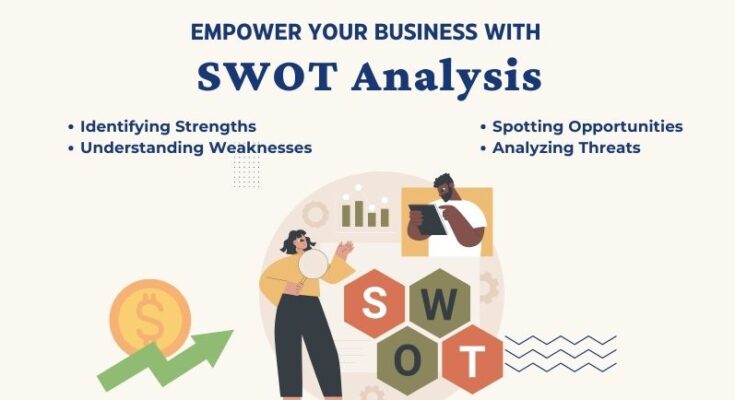Micro, Small, and Medium Enterprises (MSMEs) businesses often face unique challenges, ranging from limited resources and market competition to adapting to technological advancements. To navigate through these challenges effectively, MSMEs require a strategic tool that can provide actionable insights into their internal Strengths and Weaknesses, as well as the external Opportunities and Threats in their operating environment. This is where the SWOT analysis comes into play.
SWOT Analysis: An Overview
SWOT analysis, an acronym for Strengths, Weaknesses, Opportunities, and Threats, is a strategic management tool that assesses the internal and external factors influencing an organization. The analysis helps businesses identify key areas to Leverage Strengths, Address Weaknesses, Seize Opportunities, and Mitigate potential Threats. The comprehensive evaluation empowers MSMEs to make informed decisions, enhance their competitiveness, and chart a successful path forward in a dynamic market.
Identifying Internal Strengths
The first step in conducting a SWOT analysis is to identify the internal strengths of an MSME. These may include factors such as a skilled and dedicated workforce, a unique product or service offering, a strong brand reputation, efficient internal processes, and effective management practices. By recognizing and capitalizing on these strengths, MSMEs can create a solid foundation for growth and sustainable success.
For instance, a small artisanal bakery with a reputation for producing high-quality, handmade pastries and bread can leverage its unique recipes and exceptional craftsmanship to attract a loyal customer base and differentiate itself from larger, mass-produced bakeries.
Addressing Internal Weaknesses
Every MSME has its share of weaknesses, and a SWOT analysis helps bring them to light. These weaknesses could be inadequate infrastructure, a limited product range, poor financial management, or insufficient marketing efforts. Addressing these internal weaknesses is essential to fortify the organization and minimize potential risks.
For example, a small software development company may identify that its developers lack expertise in the latest programming languages. Addressing this weakness through training and upskilling initiatives can enhance the company’s ability to take on more diverse and complex projects.
Seizing External Opportunities
Beyond internal factors, SWOT analysis also focuses on identifying external opportunities that an MSME can capitalize on. These opportunities may arise from changes in market trends, emerging technologies, shifts in consumer preferences, or untapped niches in the industry. By seizing these opportunities, MSMEs can expand their market presence and gain a competitive advantage.
Consider a small eco-friendly cleaning product manufacturer that identifies an increasing demand for sustainable alternatives in the market. By launching new eco-friendly product lines, the company can tap into this growing trend and attract environmentally conscious consumers.
Mitigating External Threats
Just as identifying opportunities is vital, so too is recognizing potential threats in the external environment. These threats may include intense competition, changing regulations, economic downturns, or disruptive innovations. By proactively addressing these threats, MSMEs can safeguard their operations and stay ahead of the curve.
For example, a medium-sized fashion retailer operating primarily through physical stores may realize the growing threat of e-commerce giants. To mitigate this threat, the retailer could enhance its online presence, invest in e-commerce infrastructure, and offer personalized shopping experiences to retain and attract customers.
How SWOT Analysis helps business owners?
Enhancing Decision-Making
SWOT analysis provides MSME owners and managers with valuable insights that inform their decision-making process. The analysis ensures that decisions are based on a thorough understanding of the company’s internal capabilities and limitations, as well as the external factors shaping the business environment. Consequently, this empowers MSMEs to make strategic choices that align with their long-term objectives.
For instance, a microbrewery that performs a SWOT analysis might discover that its location lacks visibility and accessibility. Armed with this information, the brewery can decide to relocate to a more strategic area with higher foot traffic, increasing its chances of attracting more customers and boosting sales.
Streamlining Business Operations
SWOT analysis acts as a diagnostic tool for MSMEs, enabling them to assess their current state of affairs comprehensively. By analyzing internal processes, identifying bottlenecks, and understanding inefficiencies, businesses can streamline their operations and improve overall productivity.
A small software startup may find that its internal communication and project management processes are causing delays and hampering collaboration. Based on this insight, the company can adopt efficient project management tools and enhance communication protocols to boost team productivity and product delivery timelines.
Fostering Innovation and Adaptability
In the rapidly changing business landscape, adaptability and innovation are critical to the survival of MSMEs. SWOT analysis fosters a culture of continuous improvement by encouraging businesses to embrace change, explore new opportunities, and innovate in response to evolving market demands.
For instance, a small family-owned restaurant may conduct a SWOT analysis and realize the increasing demand for healthier food options. By revamping their menu to include more nutritious choices, they can attract health-conscious customers and adapt to changing dietary preferences.
Resource Allocation and Risk Management
Limited resources are a common challenge faced by MSMEs. SWOT analysis aids in optimal resource allocation by prioritizing initiatives that align with the company’s strengths and opportunities, while also considering ways to address weaknesses and mitigate threats.
Additionally, by understanding potential risks and vulnerabilities, MSMEs can develop contingency plans to safeguard their operations in times of crisis or uncertainty. This risk management approach enhances their resilience and reduces the negative impact of unforeseen events.
SWOT analysis holds immense importance for Micro, Small, and Medium Enterprises (MSMEs) by providing a structured and comprehensive assessment of their internal strengths and weaknesses, as well as external opportunities and threats. SWOT analysis becomes a crucial driver of success and sustainability for MSMEs, enabling them to thrive and contribute significantly to the growth of the economy at large. If you want to leverage SWOT to accelerate your business growth, reduce overhead expenses, smooth streamlined operations, and various other direct-indirect benefits, avail advisory or mentorship from MSME HelpDesk experts. Also, start following MSME HelpDesk on social media to enhance your knowledge and network without any additional expense.

